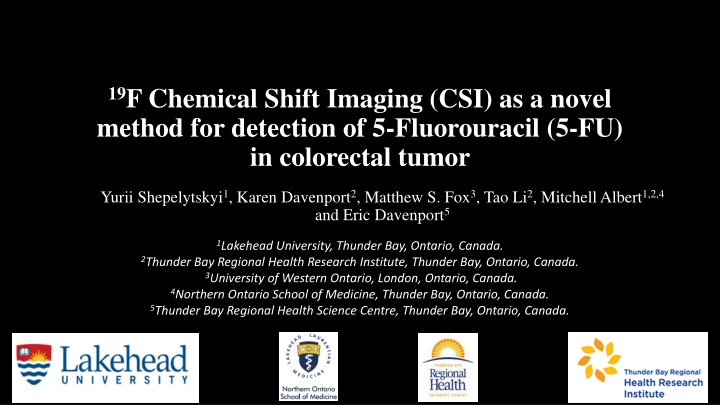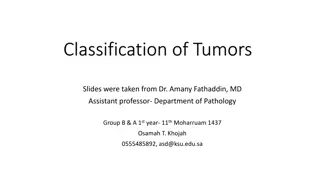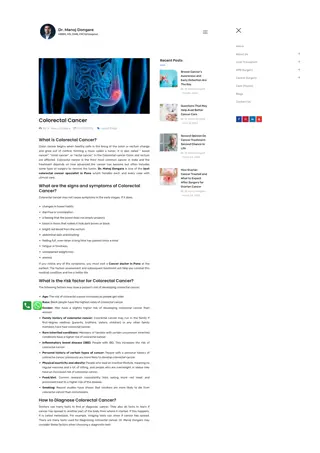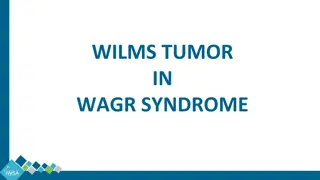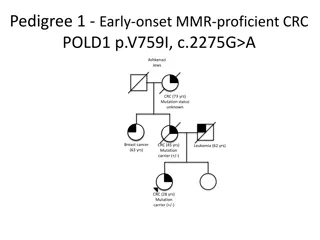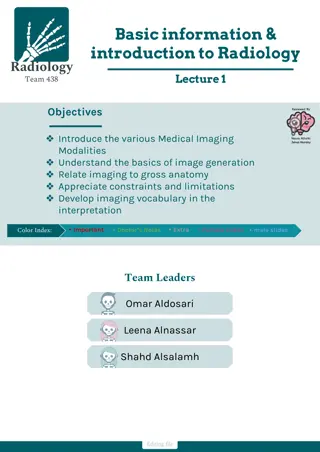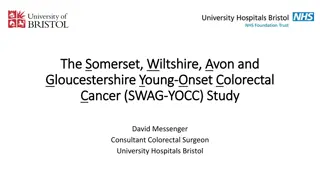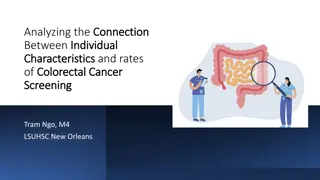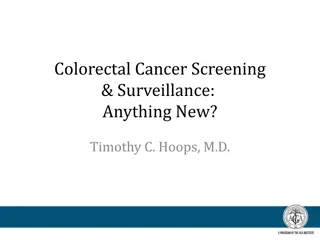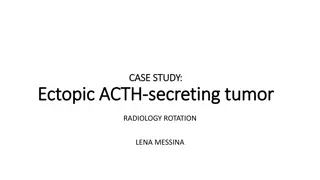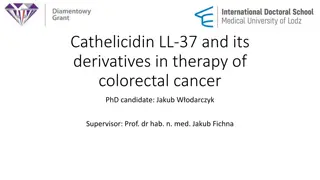19F Chemical Shift Imaging for 5-Fluorouracil Detection in Colorectal Tumor
This study introduces 19F Chemical Shift Imaging (CSI) as a novel method for detecting 5-Fluorouracil (5-FU) in colorectal tumors. The research focuses on the significance of 5-FU in cancer treatment, highlighting the need for early resistance detection methods. Utilizing 19F Magnetic Resonance Imaging, the study explores the metabolization of 5-FU into fluorinated compounds with distinct chemical shifts. The materials and methods section outlines the experimental setup involving mouse models with different tumor types, injections of 5-FU, and imaging parameters for 19F CSI.
Download Presentation

Please find below an Image/Link to download the presentation.
The content on the website is provided AS IS for your information and personal use only. It may not be sold, licensed, or shared on other websites without obtaining consent from the author.If you encounter any issues during the download, it is possible that the publisher has removed the file from their server.
You are allowed to download the files provided on this website for personal or commercial use, subject to the condition that they are used lawfully. All files are the property of their respective owners.
The content on the website is provided AS IS for your information and personal use only. It may not be sold, licensed, or shared on other websites without obtaining consent from the author.
E N D
Presentation Transcript
19F Chemical Shift Imaging (CSI) as a novel method for detection of 5-Fluorouracil (5-FU) in colorectal tumor Yurii Shepelytskyi1, Karen Davenport2, Matthew S. Fox3, Tao Li2, Mitchell Albert1,2,4 and Eric Davenport5 1Lakehead University, Thunder Bay, Ontario, Canada. 2Thunder Bay Regional Health Research Institute, Thunder Bay, Ontario, Canada. 3University of Western Ontario, London, Ontario, Canada. 4Northern Ontario School of Medicine, Thunder Bay, Ontario, Canada. 5Thunder Bay Regional Health Science Centre, Thunder Bay, Ontario, Canada.
Yurii Shepelytskyi Relationships with commercial interests: NONE Potential for conflict(s) of interest: NONE
Significance Colorectal cancer is the third most common cause of cancer death worldwide1 5-Fluorouracil (5-FU) is one of the most widely used cytotoxic chemotherapies for treatment of variety of solid cancers, including colorectal and breast cancer2 Low response rates for chemotherapy based on 5-FU is limitation factor for clinical usage3 It has been clinically demonstrated that trapping phenomenon (retaining of drug in the tumor) correlates with the clinical effectiveness of 5-FU chemotherapy4 Method to detect resistance of tumor to 5-FU is needed in earliest stages of treatment 1 www.who.int, 2017; 2Longley DB, et al., Nature Reviews Cancer, 2003; 3G. Folprecht, et al., Ann Oncol, 2004; 4 Presant C. A., et al., Lancet, 1994 3
Why 19F Magnetic Resonance Imaging? [5] 5-FU metabolizes into fluorinated compounds that each display different chemical shifts, so all of them can be visualized using MRI5 Fluorine-19 (19F) has high natural abundance ( 100%) Gyromagnetic ratio of 19F is high ( = 40.05 MHz/T) High MRI signal Absence of 19F compounds in the body No background signal! MRI is a non-invasive and non-ionizing imaging technique 4 5Jordan A. Lovis, Matthew S. Fox, Iain K. Ball, Tao Li, Marcus J. Couch, and Mitchell S. Albert.. Proc. ISMRM. 2014.
Materials and Methods HT 29 (non respondent to 5-FU treatment ) and H-508 (respondent to 5-FU chemotherapy ) tumors 9 mice with HT 29 tumor, 9 mice with H 508 tumor, 5 mice with both tumor types All animals received a bolus tail vein injection of 5-FU (300uL of 5-FU) 1H localizer (TSE) parameters: FOV = 75x75 mm2, 256x256 resolution, TR/TE = 2000/55.19 ms, slice thickness 2 mm, 16 slices, NSA = 3 19F CSI parameters: Matrix size = 8x5 or 3x5; FOV = 20x50 or 31x18.6 mm2 , TR/TE = 5000/4.27 ms, number of averages 3 or 9, spectral bandwidth = 32 kHz 5
19F Chemical Shift Imaging Chemical Shift Image 6
Results 7
19F CSI images superimposed on the 1H localizer of representative mouse with HT-29 (non-responder) tumor (A&C) and mouse with H-508 (5-FU responder) tumor (B&D) Lung H-508 A & B acquired at 7.5 min. after bolus Liver Liver HT-29 C & D acquired at 40 min. after injection Bladder Bladder At 40 min., signal was concentrated in the H-508 tumor (D), bladder and kidneys (C,D) Kidney HT-29 H-508 Bladder Bladder Kidneys 8
Time course of 5-FU SNR from the tumor, liver, and bladder voxels for representative mouse with a HT-29 tumor (A) and mouse with a H-508 tumor (B) The H-508 SNR time curve significantly different from the liver SNR time dependence The HT-29 SNR curve is not different from the liver SNR time curve 9
19F CSI images superimposed on the 1H localizer of representative mouse with both HT-29 (non-responder)(left flank) and H-508 (5-FU responder)(right flank) tumors A & B acquired at 5 and 70 min. after 5-FU injection At 70 minutes, signal was concentrated in the H-508 tumor, bladder and kidneys (B) Kidneys HT-29 The H-508 SNR in (B) was two times higher than at (A) H-508 The HT-29 SNR dropped more than 3 times (B) 10
5-FU SNR time curves from the HT-29 (left tumor) ,the H-508 (right tumor), and the bladder of representative mouse which had both tumor types The HT-29 tumor time curve is significantly different from the H-508 tumor SNR curve (p < 0.01) 11
Statistical analysis of time curves for HT-29 and H-508 tumors Fitting function ? ? = ???? b value shows dynamic of signal (b<0 decreasing, b > 0 - increasing) Two-sample t test was applied to the time constant A Wilcoxon signed rank test has been used to evaluate the difference between SNR time curves obtained from different organs. 12
Discussion and Conclusion The results of this study illustrate the feasibility of detecting a 5-FU trapping effect in different types of colorectal cancer using 19F CSI The signal from the H-508 tumor tends to increase with time, whereas the signal from the HT-29 tumor shows a tendency to decrease or to remain constant (p < 0.01) No fluorinated metabolites were observed This study provided proof of principle that we can use 19F CSI to detect the resistivity of different types of colorectal cancer to 5-FU chemotherapy in humans 13
Acknowledgments Dr. Mitchell Albert Dr. Karen Davenport Dr. Eric Davenport Tao Li Dr. Matthew S. Fox Peter Smylie Jordan Lovis This work was supported by a grant from the Northern Ontario Academic Medicine Association (NOAMA). Lakehead University and Thunder Bay Regional Health Research Institute provided partial support and access to their facilities. 14
